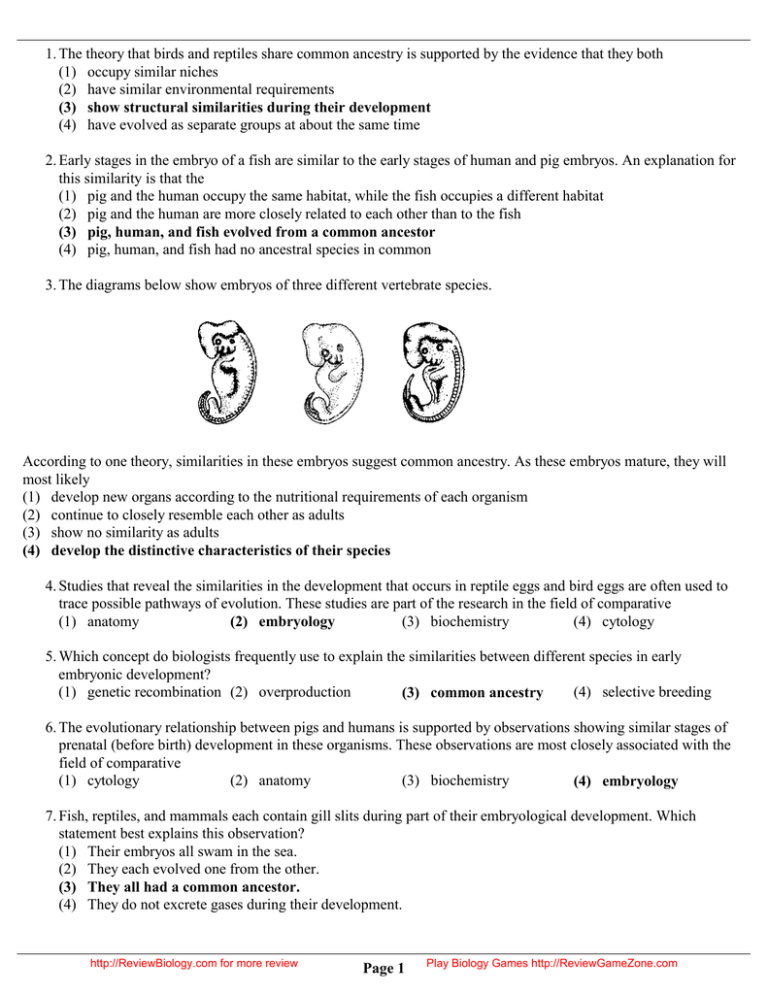1. The theory that birds and reptiles share common ancestry is
advertisement

1. The theory that birds and reptiles share common ancestry is supported by the evidence that they both (1) occupy similar niches (2) have similar environmental requirements (3) show structural similarities during their development (4) have evolved as separate groups at about the same time 2. Early stages in the embryo of a fish are similar to the early stages of human and pig embryos. An explanation for this similarity is that the (1) pig and the human occupy the same habitat, while the fish occupies a different habitat (2) pig and the human are more closely related to each other than to the fish (3) pig, human, and fish evolved from a common ancestor (4) pig, human, and fish had no ancestral species in common 3. The diagrams below show embryos of three different vertebrate species. According to one theory, similarities in these embryos suggest common ancestry. As these embryos mature, they will most likely (1) develop new organs according to the nutritional requirements of each organism (2) continue to closely resemble each other as adults (3) show no similarity as adults (4) develop the distinctive characteristics of their species 4. Studies that reveal the similarities in the development that occurs in reptile eggs and bird eggs are often used to trace possible pathways of evolution. These studies are part of the research in the field of comparative (1) anatomy (3) biochemistry (4) cytology (2) embryology 5. Which concept do biologists frequently use to explain the similarities between different species in early embryonic development? (1) genetic recombination (2) overproduction (4) selective breeding (3) common ancestry 6. The evolutionary relationship between pigs and humans is supported by observations showing similar stages of prenatal (before birth) development in these organisms. These observations are most closely associated with the field of comparative (1) cytology (2) anatomy (3) biochemistry (4) embryology 7. Fish, reptiles, and mammals each contain gill slits during part of their embryological development. Which statement best explains this observation? (1) Their embryos all swam in the sea. (2) They each evolved one from the other. (3) They all had a common ancestor. (4) They do not excrete gases during their development. http://ReviewBiology.com for more review Page 1 Play Biology Games http://ReviewGameZone.com 8. Which observation provides the best evidence that two different animals most likely have a common ancestor? (1) They choose the same plants for food. (2) They both burrow into the ground for shelter. (3) They have similarities in early embryonic development. (4) They both inhabit the same environment. 9. Two organisms are closely related and are thought to share a similar evolutionary history. If this assumption is correct, these organisms most likely have (3) identical chromosome mutations (1) no structural differences (2) few biochemical similarities (4) similar embryological development 10. The embryos of fish, chickens, and pigs have gill slits and a tail. The presence of these features suggests that (1) all these animals can swim (2) pigs developed from chickens (3) these animals may have had a common ancestor (4) gill slits and tails are required for embryonic development 11. In the early stages of development, the embryos of dogs, pigs, and humans resemble one another. This observation suggests that these animals may have (3) the same blood components (1) a similar number of chromosomes (2) similar habitat requirements (4) a common ancestry 12. Insulin extracted from cattle is so similar to the insulin of humans that it is used to treat human diabetics. This similarity is an example of a type of evidence for evolution gained from comparative (1) anatomy (2) embryology (4) fossil study (3) biochemistry 13. If a rabbit is sensitized to human blood, the blood of the rabbit will react to chimpanzee blood very much the way it does to human blood. This is an example of which type of evidence supporting the theory of evolution? (3) comparative embryology (1) comparative habitat (2) comparative anatomy (4) comparative biochemistry 14. From the information given in the chart below, which two organisms are most closely related? (1) A and B (2) B and C (3) C and D (4) D and B 15. The blood of rhesus monkeys contains proteins similar to those found in the blood of humans. This observation suggests that rhesus monkeys and humans (3) have identical chromosomes (1) belong to the same genus (4) occupy the same niche (2) may have a common ancestor http://ReviewBiology.com for more review Page 2 Play Biology Games http://ReviewGameZone.com


